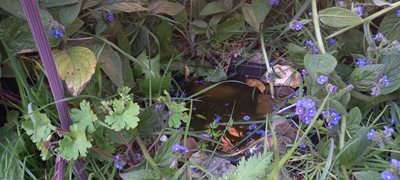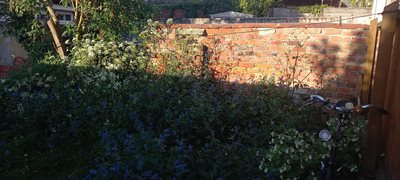Are you working with a small garden space or a smaller budget, but still want to get involved in some gardening? NWT Communications Intern: Diversity, Meg Watts, has some tips!
The size of your patch doesn't dictate its benefit to nature; we can all help to bring a little wildlife into our outdoor spaces. Whether your space is rented, clad in concrete or you're working on a shoestring budget, these simple actions can make a home for local wildlife, whilst also creating a lovely outdoor environment for you to enjoy too.
What makes up a wild garden?
For native wildlife like bees, pollinating insects, hedgehogs and birds to thrive, we need to provide 4 separate elements:
-
Access to drinking water
-
Access to a place to shelter (and breed!)
-
Feeding opportunities
-
Travel corridors to connecting wild spaces
This might sound overwhelming, but a few simple changes to your outdoor space can provide a wealth of opportunities for local wildlife.

Create a simple pond (photo: Meg Watts)
Creating a pond
Creating a pond in your garden is one of the most effective ways to improve biodiversity and enable local wildlife's success for years to come. I rent a student property, so I couldn't dig a pond for obvious reasons, but what I have done is dug a small amount of soil out of a sunny corner of my garden to partially sink a washing up bowl. It doesn't need to be a lot of water; just enough to provide birds with somewhere to bathe, and other animals with somewhere to drink. I've filled the washing bowl with stones and fallen bricks from the wall to create a hedgehog-friendly ramp out of the pond. Even a bird bath will be an excellent addition to your outdoor space, particularly if you provide bird seed too; I found this really cool window feeder made out of two suction cups and an empty takeaway box, which could be a brilliant bird viewing opportunity for those limited on space.
Creating a mud tray
Another slightly stranger watery addition is a mud tray for house martins. My dad taught me this trick, and I do it every year round about this time, when migrating house martins are building their nests under the eaves of houses. House martins use a DIY mud and saliva mix to build their nests, which can be particularly difficult in drier seasons - that's why it helps to give them some materials to start off with. Simply fill a shallow tray (it can be a baking tray, Tupperware or takeaway plastic container) with mud and place in an elevated position (away from cats).

Let your garden grow wild (photo: Meg Watts)
Creating shelter
A simple and enjoyable addition to the garden is the humble bug pile, or insect hotel if you're feeling fancy. In my garden, building a bug pile literally equated to piling up deadwood and bamboo I found when I moved in, however these projects can be as simple or elaborate as you would like. Bee hotels are also particularly useful for solitary bees, and again, can be as simple or fancy as you'd like - just make sure they're situated in a warm and sunny spot. If you're in rented accommodation, it's also worth asking your landlord if you can install bird boxes or 'hedgehog holes' in any fences. It's a simple fix, but these holes create a safe network of passages for the humble hedgehog (away from major roads).
When it comes to shelter and travel corridors, there's a very easy fix here; be a little kinder to your weeds. Plants like mallows and long grass provide excellent habitats for insects, as well as creating corridors of easily accessible food for pollinating insects. So, if you can, leave a corner of your garden wild. You can even plant some wildflower seed in these areas to create your own wild corner from scratch, or forage about for existing seeds and plants in your neighbourhood - I collected various poppy seeds from the flowerbeds in Norwich's Chapelfield gardens last summer, simply by shaking the dried seed heads into a ziplock bag. I've also found that my neighbours welcome me taking the odd rosemary or lavender cutting; although not native, these plants provide excellent pollination opportunities for insects, can be easily grown from cuttings, and thrive both in pots and directly in the soil.
Get involved!
We've taken a whistle-stop tour of low budget wild gardening, but there's always more to learn: NWT's Wildlife Information Service is an invaluable resource when it comes to helping Norfolk's wildlife. There's a whole world of nature conservation in Norfolk; I've found that locally based Facebook communities for swapping plants, tools, knowledge and resources have enabled me to do so much more in my space. Social farms and community gardens are also a brilliant resource; providing you with a community and outdoor space to enjoy, ensuring that everyone and everything can benefit from a biodiverse Norfolk.
If you're feeling inspired, it's not too late to get involved with this year's 30 Days Wild! Sign up to enjoy completing simple, fun and exciting Random Acts of Wildness every day throughout June! You might also want to take a look at our exciting Bishop's Garden project, which is all about finding out what wildlife can be found in an urban garden.
Meg Watts is Communications Intern: Diversity at NWT.
Header image: Leafcutter bee on insect hotel by Vaughn Matthews